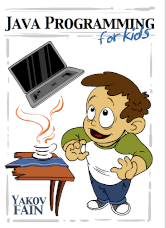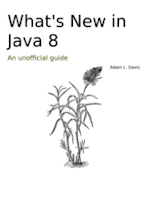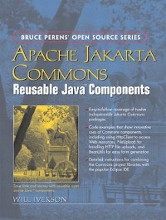Last Updated on September 19, 2024
7. Java Programming for Kids by Yakov Fain
 Java Programming for Kids is written for kids aged 12+ and adults wanting a gentle introductory Java book.
Java Programming for Kids is written for kids aged 12+ and adults wanting a gentle introductory Java book.
The book begins with an introduction to Java and then explains how to write GUI programs illustrating with Tic-Tac-Toe and Ping-Pong games. The book gives good treatment to the basics – classes, Java building blocks, interfaces, lambdas, abstract and anonymous classes are covered. The author then proceeds to examine access levels, collections, generics, multi-threading before offering an introduction to GUI with JavaFX, a library that’s included with JDK, and you can write your GUI programs using familiar Java language.
The reader also learns how to handle run-time errors (known as exceptions), and how to work with files and serialization.
The online version of this book is offered for free under an Creative Commons license.
8. What’s New in Java 8 by Adam L. Davis
 What’s New in Java 8 is a short introduction to Java 8, the only publicly supported version. The book aims to offer a basic understanding of the new features and be ready to start using it. You’ll need a good understanding of Java the language and the JVM to reap the full benefits of the book. The author helps you understand Java 8, including Project Lambda, the new Date-Time API, Streams, Nashorn, and more.
What’s New in Java 8 is a short introduction to Java 8, the only publicly supported version. The book aims to offer a basic understanding of the new features and be ready to start using it. You’ll need a good understanding of Java the language and the JVM to reap the full benefits of the book. The author helps you understand Java 8, including Project Lambda, the new Date-Time API, Streams, Nashorn, and more.
Java 8 includes the following:
- Lambda expressions – an anonymous function that you can use to create delegates or expression tree types
- Method references – compact, easy-to-read lambda expressions for methods that already have a name
- Default Methods (Defender methods)
- A new Stream API
- Optional type – a new container type that wraps a single value, if the value is available
- A new Date/Time API.
- Nashorn, the new JavaScript engine – extends Java’s capabilities by running dynamic JavaScript code natively on the JVM
- Removal of the Permanent Generation
- and more…
This book is licensed under Creative Commons Attribution-NonCommercial-ShareAlike 3.0 Unported (CC BY-NC-SA 3.0).
9. Apache Jakarta Commons: Reusable Java Components by Will Iverson
 This book is a Java developer’s guide to the Apache Jakarta Commons project. It covers, in detail, the twelve most important Jakarta Commons packages, covering topics ranging from HTTP FileUpload to database connectivity, with sample program code provided for each.
This book is a Java developer’s guide to the Apache Jakarta Commons project. It covers, in detail, the twelve most important Jakarta Commons packages, covering topics ranging from HTTP FileUpload to database connectivity, with sample program code provided for each.
It also offers instruction on how to combine the Commons project libraries with Eclipse.
This book is part of Bruce Perens’ Open Source Series. All books in this series are released under the Open Publication License, v1.0 or later.
Next page: Page 4 – Object Oriented Programming using Java and more books
Pages in this article:
Page 1 – Introduction to Programming Using Java and more books
Page 2 – Java Application Development on Linux and more books
Page 3 – Java Programming for Kids and more books
Page 4 – Object Oriented Programming using Java and more books
Page 5 – Java Structures and more books
All books in this series:
| Free Programming Books | |
|---|---|
| Ada | ALGOL-like programming language, extended from Pascal and other languages |
| Agda | Dependently typed functional language based on intuitionistic Type Theory |
| Arduino | Inexpensive, flexible, open source microcontroller platform |
| Assembly | As close to writing machine code without writing in pure hexadecimal |
| Awk | Versatile language designed for pattern scanning and processing language |
| Bash | Shell and command language; popular both as a shell and a scripting language |
| BASIC | Beginner’s All-purpose Symbolic Instruction Code |
| C | General-purpose, procedural, portable, high-level language |
| C++ | General-purpose, portable, free-form, multi-paradigm language |
| C# | Combines the power and flexibility of C++ with the simplicity of Visual Basic |
| Clojure | Dialect of the Lisp programming language |
| ClojureScript | Compiler for Clojure that targets JavaScript |
| COBOL | Common Business-Oriented Language |
| CoffeeScript | Transcompiles into JavaScript inspired by Ruby, Python and Haskell |
| Coq | Dependently typed language similar to Agda, Idris, F* and others |
| Crystal | General-purpose, concurrent, multi-paradigm, object-oriented language |
| CSS | CSS (Cascading Style Sheets) specifies a web page’s appearance |
| D | General-purpose systems programming language with a C-like syntax |
| Dart | Client-optimized language for fast apps on multiple platforms |
| Dylan | Multi-paradigm language supporting functional and object-oriented coding |
| ECMAScript | Best known as the language embedded in web browsers |
| Eiffel | Object-oriented language designed by Bertrand Meyer |
| Elixir | Relatively new functional language running on the Erlang virtual machine |
| Erlang | General-purpose, concurrent, declarative, functional language |
| F# | Uses functional, imperative, and object-oriented programming methods |
| Factor | Dynamic stack-based programming language |
| Forth | Imperative stack-based programming language |
| Fortran | The first high-level language, using the first compiler |
| Go | Compiled, statically typed programming language |
| Groovy | Powerful, optionally typed and dynamic language |
| Haskell | Standardized, general-purpose, polymorphically, statically typed language |
| HTML | HyperText Markup Language |
| Icon | Wide variety of features for processing and presenting symbolic data |
| J | Array programming language based primarily on APL |
| Java | General-purpose, concurrent, class-based, object-oriented, high-level language |
| JavaScript | Interpreted, prototype-based, scripting language |
| Julia | High-level, high-performance language for technical computing |
| Kotlin | More modern version of Java |
| LabVIEW | Designed to enable domain experts to build power systems quickly |
| LaTeX | Professional document preparation system and document markup language |
| Lisp | Unique features - excellent to study programming constructs |
| Logo | Dialect of Lisp that features interactivity, modularity, extensibility |
| Lua | Designed as an embeddable scripting language |
| Markdown | Plain text formatting syntax designed to be easy-to-read and easy-to-write |
| Objective-C | Object-oriented language that adds Smalltalk-style messaging to C |
| OCaml | The main implementation of the Caml language |
| Pascal | Imperative and procedural language designed in the late 1960s |
| Perl | High-level, general-purpose, interpreted, scripting, dynamic language |
| PHP | PHP has been at the helm of the web for many years |
| PostScript | Interpreted, stack-based and Turing complete language |
| Prolog | A general purpose, declarative, logic programming language |
| PureScript | Small strongly, statically typed language compiling to JavaScript |
| Python | General-purpose, structured, powerful language |
| QML | Hierarchical declarative language for user interface layout - JSON-like syntax |
| R | De facto standard among statisticians and data analysts |
| Racket | General-purpose, object-oriented, multi-paradigm, functional language |
| Raku | Member of the Perl family of programming languages |
| Ruby | General purpose, scripting, structured, flexible, fully object-oriented language |
| Rust | Ideal for systems, embedded, and other performance critical code |
| Scala | Modern, object-functional, multi-paradigm, Java-based language |
| Scheme | A general-purpose, functional language descended from Lisp and Algol |
| Scratch | Visual programming language designed for 8-16 year-old children |
| SQL | Access and manipulate data held in a relational database management system |
| Standard ML | General-purpose functional language characterized as "Lisp with types" |
| Swift | Powerful and intuitive general-purpose programming language |
| Tcl | Dynamic language based on concepts of Lisp, C, and Unix shells |
| TeX | Markup and programming language - create professional quality typeset text |
| TypeScript | Strict syntactical superset of JavaScript adding optional static typing |
| Vala | Object-oriented language, syntactically similar to C# |
| VHDL | Hardware description language used in electronic design automation |
| VimL | Powerful scripting language of the Vim editor |
| XML | Rules for defining semantic tags describing structure ad meaning |
